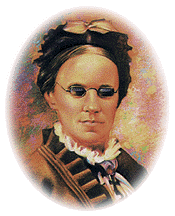
Fanny Crosby
Tell Me The Story Of Jesus
The next time you sing an old,
familiar hymn, look at the small print at the bottom of the page, and you probably will
read the name of Fanny Crosby.
Throughout her long career, she wrote more than 8,500 gospel
songs and hymns, many of which are still popular today. "To God Be The Glory,"
"Praise Him, Praise Him," "Tell Me The Story Of Jesus," "I Am
Thine O Lord" - every song is a testimony of her love for Jesus Christ.
However, this gifted poet, who described her salvation
experience as a "floodtide of celestial light," could not actually see light. In
May of 1820, when she was six weeks old, she caught a cold, and her eyes became slightly
inflamed. The regular physician in Putnam County, New York, was out of town, and a man
posing as a doctor gave her the wrong treatment. Within days, her eyesight was destroyed,
and the man fled town in a panic.
Fanny was never bitter about the stranger's intervention.
"I have not for a moment in more than eighty-five years felt a spark of resentment
against him, because I have always believed...that the good Lord...by this means
consecrated me to the work that I am still permitted to do."
Her devoted Christian parents raised Fanny to be a
confident, happy child. She dressed herself, did her own hair, and had impeccable table
manners. Known for being a mischief, Fanny spent as much time as possible climbing trees,
riding horses, and playing practical jokes on her many friends.
One of the strongest influences in Fanny's childhood was her
grandmother. An intelligent and patient woman, she took Fanny on nature walks, describing
every bud and leaf in meticulous detail. She exposed her to great literature and poetry.
Most importantly, she read her long passages from the Bible every day.
Even with such attentive teaching, Fanny's thirst for
knowledge was not satisfied; her mind was phenomenal. Before she was ten years old, she
had memorized most of the New Testament and more than five books of the Old Testament.
However, since schools at that time were not equipped to teach blind children, she was
unable to receive a regular education.
Fanny knelt with her grandmother beside her rocker and
prayed: "Dear Lord, please show me how I can learn like other children." It
wasn't long before her mother gave her the exciting news about an opportunity to attend
the New York Institute for the Blind.
Within the year, she was their best student and after
graduation became a teacher. As she grew, poetry became her passion, and she filled every
spare moment with writing verse. By the time Fanny was twenty, she was famous throughout
New York and a sought-after speaker for poetry recitations and official ceremonies.
In spite of this popularity, she still felt something was
missing from her life, and it took a severe cholera epidemic in 1849 to show her what that
was. More than half of the students at the Institute died, one of them in her arms. After
helping to nurse the sick for months, she almost succumbed to the disease herself and fled
to the country.
The deaths of those close to her shook Fanny greatly. Deep
in her heart, she knew she was not ready to die. On November 20, 1850, Fanny knelt at the
altar at a local revival and gave her heart to Jesus. Biographer Basil Miller tells her
response: "For the first time I realized that I had been trying to hold the world in
one hand and the Lord in the other," she said. Finally, the God of her grandmother
had become real to her.
Her poetry immediately reflected this change in her heart,
and songs of praise took the place of regular poems. When she met the Christian composer
William Bradbury in 1864, the friendship was almost instantaneous. Bradbury furnished the
tunes for many of Fanny's hymns; and though she worked with several composers, their
partnership was the most enduring.
Fanny usually composed dozens of songs in her head before
dictating them to a secretary, but no matter what she created, she used the same approach.
The book More Than Conquerors tells what she said about her method: "It may seem a
little old-fashioned, always to begin one's work with prayer, but I never undertake a hymn
without first asking the good Lord to be my inspiration."
She had more speaking invitations than she could keep, and
famous men such as President Polk called on her often. With so many friends and
associates, she was never lonely. Then in 1858, God brought a special man into her life,
the blind musician Alexander Van Alstyne. They were married forty-four years and had one
child, who died in infancy.
Even in her later years, Fanny stayed as busy as ever, and
not just with song writing. Always on her heart were those less fortunate, and she
volunteered much time at local ministries. Whenever someone approached her with a question
or need, she witnessed to them one-on-one and shared the light of God's Word.
Fanny died peacefully in her home in Bridgeport,
Connecticut, on February 12, 1915. The crowds at her funeral were a testimony to the
wide-spread influence she had for the Lord. These words from one of her final hymns
express the foremost hope of her life: "And I shall see Him face to face and tell the
story - saved by grace." |